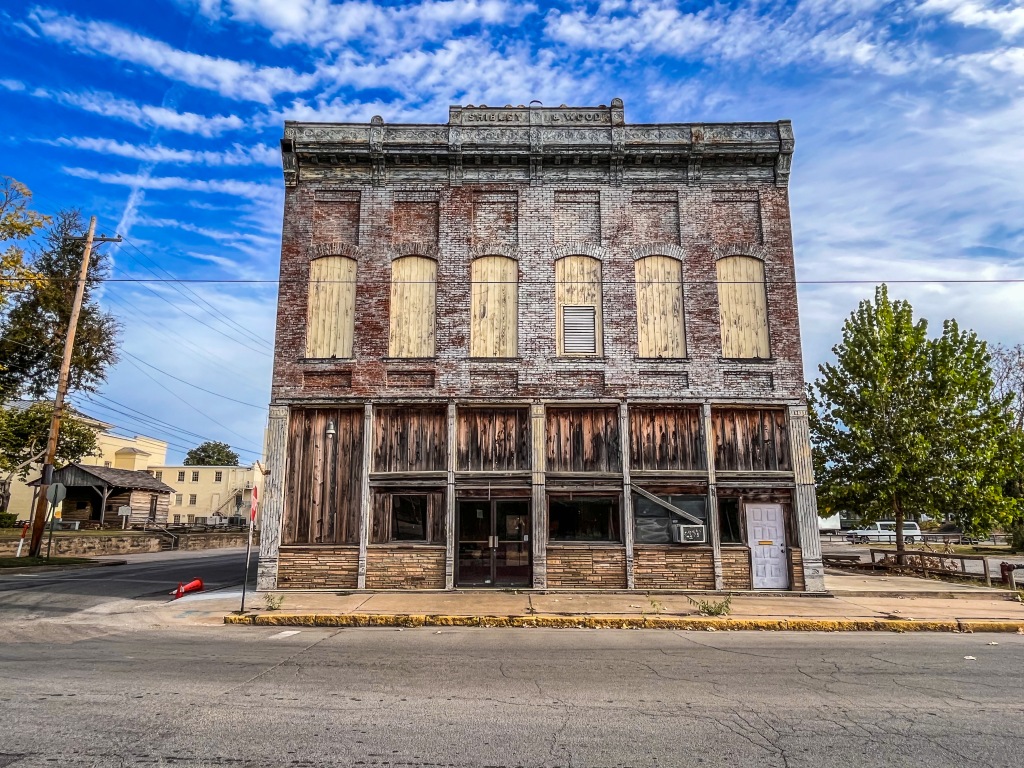A new assignment with a work colleague to prepare a set of design guidelines for a National Register-listed downtown district led me to Van Buren, Arkansas this past week. Van Buren, a community of just over 23,000 people, is the seat of Crawford County and features a linear but compact and walkable downtown lined with buildings dating from the 1880s to the 1940s. The downtown is marvelously intact for the most part with very few gaps and very few buildings with missing parts.
It was a good day for photo taking – cloudless and unseasonably warm for late October fall day. Walking downtown Van Buren is a step back in time. Right away, I was entranced by one building – the tallest, most ornate one in the downtown, the Crawford County Bank Building. The building seems to have changed very little from its late Victorian heyday. It has high integrity or “good bones” as some would say. But it looks tired and lonesome, ready for someone to lavish the building attention and care. Historic photos show its grandeur – a highly-ornamented combination of the Queen Anne and the Romanesque. Its second-floor canted bay incorporates a balcony, a nice amenity for the second-floor residence. I’m assuming the bank president lived on that floor but whoever made it home had a nice view up and downtown Main Street. When the bank failed at the onset of the Great Depression after a 40-year run, the building housed a restaurant, private dining hall, and then a call center. The grand dame of Main Street Van Buren now just sits forlorn, fending for itself.




Apart from the Crawford County Bank Building, the downtown has a restored Frisco Railroad Depot that anchors one end of Main Street with the High Victorian Italianate Crawford County Courthouse anchoring the other end. In between is a mix of one to three-story, mostly Victorian-era commercial buildings. Several of the one-story buildings have intriguing character in their own right, many with high transom-windowed storefronts, decorative attic vents, corbeled cornices, and fixed-sloping canopies. The high transom windows are quite common in downtowns in southern states but the ones in Van Buren are stunning to see. These transoms allowed for plenty of light to a store’s interior first floor but also to a mezzanine level used for both extra retail space and storage. Many fixed canopies have their original posts – at least I think they do.









A unique highlight of the trip was at the very end before heading back to the airport with a chance to visit the Drennen-Scott House, the oldest house in Van Buren, owned currently by the University of Arkansas at Fort Smith. Perched on top of a bluff overlooking downtown, it was the home of a Revolutionary War descendant John Drennen, a founder of Van Buren and brilliant businessman by all accounts. The house features many of its original furnishings and hosts a frieze that was once displayed at the World’s Columbian Exposition in 1893. There I met Tom Wing who serves as the director of the site and a professor of history at the Fort Smith campus. We were not there so much to see the house, which is quite lovely and a visitor attraction for Van Buren, but to inquire about what historic photographs may exist of downtown. We needed them for our design guidelines project. Tom was a joy to talk to – a wealth of information and his enthusiasm for the history of the Van Buren-Fort Smith region was quite infectious. He pledged to help us with our photo-collecting task.

This is my third professional engagement in Arkansas – the first was the preparation of a historic preservation plan for El Dorado and the second was a set of design guidelines for Eureka Springs. Both were wonderful projects. Each had its significant historic assets – Eureka Springs with its highly intact downtown and Victorian homes nestled within the Ozark mountainsides and El Dorado with its vibrant Main Street district and courthouse square. Van Buren has its downtown and layers of history. But I keep thinking about the Crawford County Bank Building. What an iconic piece of architecture. It deserves a better life.

